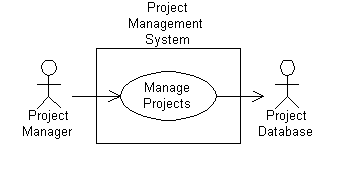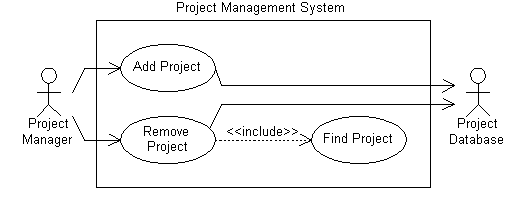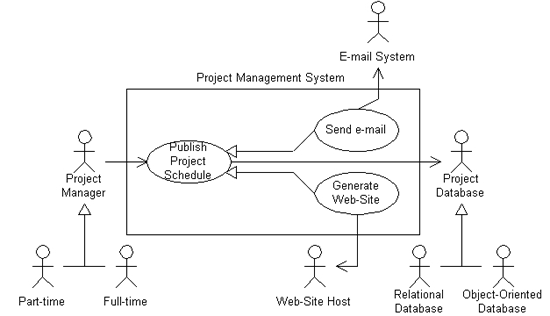
Click here to view the complete list of archived articles
This article was originally published in
the Spring 2000 issue of Methods & Tools
Click
here to reach PDF area
Understanding Use Case Modeling
Sinan Si Alhir, http://home.comcast.net/~salhir
Introduction
Following the "method wars" of the 1970s and 1980s, the Unified Modeling Language (UML) emerged from the unification that occurred in the 1990s within the information systems and technology industry. Unification was lead by Rational Software Corporation and Three Amigos, Grady Booch, James Rumbaugh, and Ivar Jacobson. The UML gained significant industry support from various organizations via the UML Partners Consortium and was submitted to and adopted by the Object Management Group (OMG) as a standard (November 17, 1997).
The UML is an evolutionary general-purpose, broadly applicable, tool-supported, and industry-standardized modeling language for specifying, visualizing, constructing, and documenting the artifacts of a system-intensive process. The language is broadly applicable to different types of systems (software and non-software), domains (business versus software), and methods and processes. The UML enables and promotes (but does not require nor mandate) a use-case-driven, architecture-centric, iterative, and incremental process that is object oriented and component based. The UML enables the capturing, communicating, and leveraging of knowledge: models capture knowledge (semantics), architectural views organize knowledge in accordance with guidelines expressing idioms of usage, and diagrams depict knowledge (syntax) for communication.
System development may be characterized as problem solving, including understanding or conceptualize and representing a problem, solving the problem by manipulating the representation of the problem to derive a representation of the desired solution, and implementing or realizing and constructing the solution. This process is very natural and often occurs subtly and sometimes unconsciously in problem solving.
Models are complete abstractions of systems. Models are used to capture knowledge (semantics) about problems and solutions. Architectural views are abstractions of models. Architectural views are used to organize knowledge in accordance with guidelines expressing idioms of usage. Diagrams are graphical projections of sets of model elements. Diagrams are used to depict knowledge (syntax) about problems and solutions. Within the fundamental UML notation, concepts are depicted as symbols and relationships among concepts are depicted as paths (lines) connecting symbols.
Use case modeling from the user model view (also known as the use case or scenario view), which encompasses a problem and solution as understood by those individuals whose problem the solution addresses, involves use case diagrams to depict the functionality of a system.
Use Case Diagrams
To successfully apply use case diagrams, we must first understand the types of elements used in use case diagrams.
Actors
Actor classes are used to model and represent roles for "users" of a system, including human users and other systems. Actors are denoted as stick person icons. They have the following characteristics:
Figure 1 shows a project management system with a project manager actor and a project database actor. The project manager is a user who is responsible for ensuring the success of project and uses the system to manage projects. The project database is a system that is responsible for housing project management data.

Figure 1
Use Cases
Use case classes are used to model and represent units of functionality or services provided by a system (or parts of a system: subsystems or classes) to users. Use cases are denoted as ellipses or ovals. They may be enclosed by a system boundary or rectangle labeled with the name of the containing system. They have the following characteristics:
Figure 1 shows a project management system which provides the functionality to manage projects in which the project manager and project database participate.
Relationships
Association relationships between actor classes and use case classes are used to indicate that the actor classes participates and communicates with the system containing the use case classes. Association relationships are denoted as solid lines or paths. Arrowheads may be used to indicate who initiates communication in the interaction. If an arrowhead points to a use case, the actor at the other end of the association initiates the interaction with the system. If the arrowhead points to an actor, the system initiates the interaction with the actor at the other end of the association.
Figure 1 shows a project management system that provides functionality to manage projects. A project manager initiates this functionality and the system initiates the communication with the project database in providing this functionality.
Includes relationships from base use case classes to inclusion use case classes are used to indicate that the base use case classes will contain the inclusion use case classes; that is, the base use case will contain the inclusion use case. A base use case defines the location at which the inclusion use case is included. Includes relationships are denoted as dashed lines or paths with an open arrow-head pointing at the inclusion use case and are labeled with the <<include>> keyword (stereotype). The insertion of the inclusion use case involves the execution of the base use case up to the inclusion point, inserting and executing the inclusion use case, and then continuing with the execution of the base use case.
Figure 2 shows that a project manager may add projects and remove projects using the project management system. When removing projects, the functionality of finding a project is included into removing a project.

Figure 2
Extends relationships from extension use case classes to base use case classes are used to indicate that the base use case classes may be augmented by the extension use case classes; that is, the inclusion use case will augment the base use case if an extension condition is satisfied. A base use case defines the extension point. An extension use case defines the extension condition that must be satisfied in order to insert the extension use case into the base use case. The insertion of the extension use case involves the execution of the base use case up to the extension point, testing the extension condition and inserting and executing the extension use case if the condition is satisfied, and then continuing with the execution of the base use case. Extends relationships are denoted as dashed lines or paths with an open arrow-head pointing at the extension use case and are labeled with the extension condition in square brackets, the <<extend>> keyword (stereotype), and the extension point name in parentheses. Extension points are identified in a compartment labeled "Extension Points" in the base use case.
Figure 3 shows that a project manager may update projects using the project management system. When updating projects, a project manager may manage tasks if the project manager selects the task option, and a project manger may manage resource if the project manager selects the resource option.

Figure 3
Generalization relationships from specialization use case classes to generalized use cases classes are used to indicate the specialization use case classes are consistent with the generalized use case classes and may add additional information. A specialization use case may be used in place of a generalized use case and may use any portions of the interaction of the generalized use case. Generalization relationships are denoted as solid lines or paths with a hollow arrow-head pointing at the generalized use case.
Figure 4 shows that a project manager may publish a project schedule by sending e-mail to project team members using an e-mail system or by generating a web-site on a web-site host. In either case, there will be common functionality used from the generalized use case, for example: inputting project name, extracting the relevant project information form the project database, etc.

Figure 4
Generalization relationships from specialization actor classes to generalized actor classes are used to indicate the specialization actor classes are consistent with the generalized actor classes and may add additional information. A specialization actor may be used in place of a generalized actor and receives the characteristics of the generalized actor. Generalization relationships between actors are denoted similarly to generalization relationships between use cases.
Figure 4 shows that there are two types project mangers, full-time and part-time, and that there are two types of project database, relational database management systems (R-DBMS) and object oriented database management systems (OO-DBMS). Any type of project manager may publish a project schedule using any type of project database.
Use Case Modeling
To successfully apply use case diagrams in use case modeling, we ought to be aware of various guidelines (lessons learned) from applying this technique.
Actors
When modeling actors, we ought to be aware of the following guidelines:
Furthermore, other guidelines may be applied in addition to those above.
Use Cases
When modeling use cases, we ought to be aware of the following guidelines:
Furthermore, other guidelines may be applied in addition to those above.
Conclusion
As the Unified Modeling Language (UML) is an evolutionary general-purpose, broadly applicable, tool-supported, and industry-standardized modeling language for specifying, visualizing, constructing, and documenting the artifacts of a system-intensive process, by understanding the types of elements used in use case diagrams and being .aware of various guidelines (lessons learned) from applying this technique, we have a sound foundation for successfully applying the technique. Furthermore, it is experience, experimentation, and application of the standard and its various techniques that will enable us to realize its benefits.